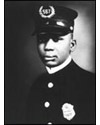|
.........
L.A. intersection named for city's first black officer killed in line of duty
fatally shot in 1923
~~~~~~~~~~~~~~~~~~~~~~~~~~~~~~~~~~~~~~~~~~~~~~~~~~~~~~~~~~~~~~~~~~~~~~~~~~~~~~~~~~~~~
 |

LAPD Officer
Charles P. Williams |
|
L.A. intersection named for city's first black officer killed in line of duty
Charles P. Williams was fatally shot downtown in 1923, but until 1998 it was believed that he was a white officer. Now, 87 years after his death, the city has corrected the oversight.
by Bob Pool
January 16, 2010 |
| |
His widow was too poor to buy a headstone for his grave.
So Los Angeles' first black police officer to be killed in the line of duty was buried in an unmarked grave when he was laid to rest 87 years ago.
This week, city leaders took steps to remedy that oversight by designating the downtown intersection of Central Avenue and 6th Street as "Officer Charles P. Williams Square."
Williams was a 35-year-old vice squad officer when he was gunned down Jan. 13, 1923, while responding to a report of an armed man threatening people at a house at 1101 E. 8th St. near the intersection.
It was later determined that the residence was being used as a brothel and that Williams' attacker was the owner of the property who was there trying to evict the prostitutes.
This marks the second time that officials have attempted to correct a decades-long oversight involving the officer's death.
Until 1998, Los Angeles Police Department records indicated that Williams was a white officer. Authorities believed that Officer Oscar Joel Bryant, who was killed in 1968, was the city's first African American officer to die in the line of duty.
But a police sergeant researching Los Angeles history by studying old newspapers at the downtown public library made the discovery that Williams was the first.
After that, authorities tracked down Williams' grave at a segregated section of Evergreen Cemetery in East Los Angeles and installed a headstone.
The marker, donated by the Los Angeles Police Memorial Foundation, is engraved with a eulogy that had been delivered by the officer's supervisor in 1923: "His achievements in the enforcement of the law will forever be a beacon of light."
Although Williams' funeral had drawn police officials and city dignitaries to the cemetery, his grave was left unmarked because his widow, the mother of his 4-year-old child, could not afford a headstone with her meager $1,000 pension.
City Councilwoman Jan Perry, who presided over unveiling ceremonies for the intersection's markers, said the commemoration is a tribute not only to Williams but to the history of the LAPD.
On hand for the ceremony was John Thomas, whose research helped rewrite departmental history.
Thomas, retired from the LAPD and now assistant chief of USC's Department of Public Safety, said confusion over Williams' death stemmed from the accidental inclusion of a photograph of a white officer named Williams in Charles P. Williams' departmental file.
Thomas said he discovered the mistake while reading microfilm copies of newspapers that reported Williams' death and the subsequent arrest of his attacker. One newspaper published a photograph of the slain officer.
"I was very surprised. Throughout my career, I'd been told that Oscar Joel Bryant was the first black officer to be killed," Thomas said.
He said his discovery sets the record straight but does not take anything away from the legacy of Bryant -- for whom a black police officers' foundation is named.
Police say the department has vastly changed since Officer Williams patrolled the streets.
"African American officers in 1923 weren't recognized as equals," said Lt. Fred Booker.
Back then, African American officers were paired and assigned to patrol black neighborhoods. In station houses, racism was pervasive.
Nonetheless, then-Police Chief Louis D. Oaks was awakened with news of Williams' shooting and personally led a manhunt for his killer.
Witnesses to the 8th Street attack identified the shooter as John Pryor, a 50-year-old plasterer who owned the house being used a brothel.
Williams and his partner were working undercover when they were flagged down about 9:30 p.m. by a man reporting that a person waving a revolver was threatening people at the house.
Williams was aware that the residence was a brothel but was unaware that Pryor was acting as a vigilante and attempting to remove the prostitutes from the premises.
When Williams ordered Pryor to put his hands up, Pryor fired twice, hitting the officer in the stomach. As he fell, Williams managed to shoot Pryor in the leg. A passing truck driver carried Williams to the hospital, where he died from his wound.
Pryor later claimed that he fired in self-defense, not realizing that Williams was an undercover officer.
Investigators discovered that Pryor had earlier called the Police Department and requested that authorities raid the house, advising that he would be there to meet officers. Records do not indicate what became of Pryor after his arrest.
Authorities said Williams has no living relatives in Los Angeles.
But they say they don't intend to again forget the first black officer to die in the line of duty. |
|
|
 |

|